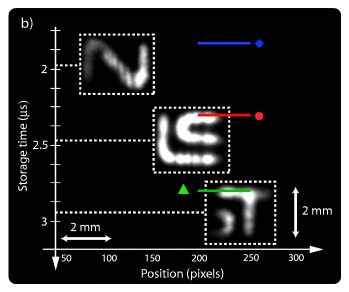How to store images in a cloud of moving atoms
April 5, 2013

Retrieved portions of the NIST logo as function of storage time and horizontal position. The NIST logo was stored once as a single input using a single pulse of the write beam. (Credit: Jeremy B Clark, Quentin Glorieux and Paul D Lett/New Journal of Physics)
Scientists at the Joint Quantum Institute (JQI) of the National Institute of Standards and Technology (NIST) and the University of Maryland have demonstrated that they can store visual images in a thin vapor of rubidium atoms.
The effort may prove helpful in creating memory for quantum computers.
Their work builds on an approach developed at the Australian National University, where scientists showed that a rubidium vapor could be manipulated in interesting ways using magnetic fields and lasers.
The vapor is contained in a small tube and magnetized, and a laser pulse made up of multiple light frequencies is fired through the tube.
The energy level of each rubidium atom changes depending on which frequency strikes it, and these changes within the vapor become a sort of fingerprint of the pulse’s characteristics.
If the field’s orientation is flipped, a second pulse fired through the vapor takes on the exact characteristics of the first pulse — in essence, a readout of the fingerprint.

Generation of the probe, write, and individual read beams (credit: Jeremy B Clark, Quentin Glorieux and Paul D Lett/New Journal of Physics)
Not vaporware
“With our paper, we’ve taken this same idea and applied it to storing an image — basically moving up from storing a single ‘pixel’ of light information to about a hundred,” says Paul Lett, a physicist with JQI and NIST’s Quantum Measurement Division. “By modifying their technique, we have been able to store a simple image in the vapor and extract pieces of it at different times.”
It’s a dramatic increase in the amount of information that can be stored and manipulated with this approach. But because atoms in a vapor are always in motion, the image can only be stored for about 10 milliseconds, and in any case the modifications the team made to the original technique introduce too much noise into the laser signal to make the improvements practically useful.
“What we’ve done here is store an image using classical physics. However, the ultimate goal is to store quantum information, which a quantum computer will need,” he says. “Measuring what the rubidium atoms do as we manipulate them is teaching us how we might use them as quantum bits and what problems those bits might present. This way, when someone builds a solid-state system for a finished computer, we’ll know how to handle them more effectively.”